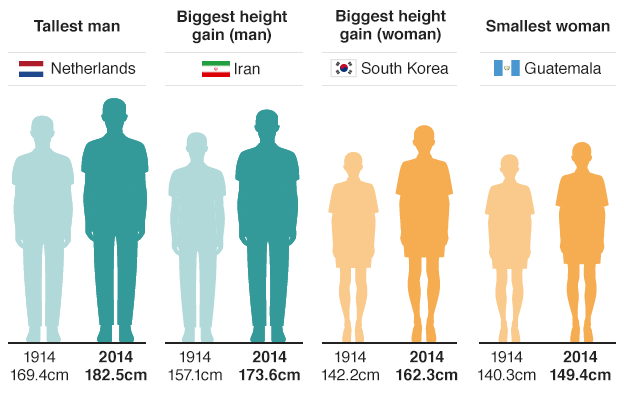Top 10 Countries Where Men Stand Tallest

The average height of men varies across the world, influenced by genetics, diet, and living conditions. Some countries are renowned for producing taller men due to a mix of hereditary factors and high living standards. Here’s a closer look at ten countries where men stand among the tallest, including insights into why height has become a cultural and physiological characteristic in these regions.
1. Netherlands
Dutch men have consistently ranked among the tallest, with an average height of around 6 feet (1.83 meters). This remarkable stature is attributed to a mix of factors, including genetic predispositions and the Netherlands’ high standard of living. The Dutch diet, which includes a healthy balance of dairy, proteins, and other nutrient-dense foods, supports bone growth and physical development. Additionally, the Netherlands’ robust healthcare system ensures that children grow up healthy, further supporting height as a common trait among the population.
2. Denmark
Denmark follows closely, with an average male height of nearly 6 feet (1.82 meters). Danish genetics and an emphasis on balanced nutrition, with plenty of dairy and meat, contribute to this average. Denmark’s emphasis on physical fitness and wellness is also a contributing factor, as Danish culture often encourages outdoor activities and sports from an early age. Danish families also benefit from accessible healthcare, ensuring that children receive the support they need to reach their full growth potential.
3. Iceland
Icelandic men are known for their impressive height, with an average of approximately 5 feet 11 inches (1.81 meters). Scandinavian genetics, which favor taller builds, are a key factor here. Iceland’s traditional diet, which includes a lot of fish and lean meats, supports physical growth and health. The nation’s high standard of living and low-stress lifestyle have a beneficial impact on overall health, allowing genetic potential to flourish. Icelandic people tend to be very active, which further supports their stature.
4. Norway
Norwegian men have an average height close to 5 feet 11 inches (1.8 meters). Norway shares a similar genetic makeup with other Scandinavian countries, which is known for producing taller individuals. The Norwegian diet is rich in seafood and dairy, both of which provide essential nutrients that support bone density and growth. Like their Danish counterparts, Norwegians emphasize health and wellness, and children are encouraged to engage in sports and outdoor activities, further promoting their growth.
5. Serbia
Serbian men, along with men from other Balkan countries, have an average height around 5 feet 11 inches (1.8 meters). Balkan genetics, combined with a diet high in proteins, play a significant role in the height seen in this region. Traditional Serbian cuisine includes meats, dairy, and vegetables that help support robust health. Socioeconomic improvements in recent decades have also enhanced access to quality healthcare and nutrition, further impacting height in Serbia.
6. Croatia
Croatia shares similar height averages with Serbia and other neighboring Balkan nations, with men averaging around 5 feet 11 inches. Genetic factors have a strong influence here, as the Balkans have long been associated with taller populations. Croatian cuisine, rich in seafood, dairy, and a variety of meats, provides essential nutrients that contribute to height and overall health. The country’s emphasis on sports, particularly basketball, encourages young people to develop strong and healthy bodies.
7. Montenegro
Montenegro is another Balkan country with tall men, with an average height close to 6 feet. Montenegrin genetics and traditional diets high in meats, dairy, and other protein-rich foods are key contributors. Cultural factors, such as an active lifestyle and a preference for sports, help reinforce physical development from a young age. Improved economic conditions in Montenegro have also led to better healthcare and nutrition access, further supporting growth potential.
8. Estonia
Estonian men stand tall with an average height of about 5 feet 10.5 inches (1.79 meters). Estonians have a unique genetic mix influenced by Baltic and Nordic ancestry, which has contributed to their height. Estonian diets, rich in proteins, vegetables, and dairy, provide the essential nutrients required for bone growth. The country’s focus on health and wellness, particularly through sports and outdoor activities, reinforces physical development.
9. Czech Republic
Czech men average around 5 feet 10 inches (1.78 meters) in height. The genetic makeup of the Czech population, influenced by central European ancestry, supports taller heights. Traditional Czech foods, which often include meats, dairy, and bread, provide a substantial amount of protein and calcium, which are beneficial for height growth. The country’s improved healthcare services and emphasis on fitness have further contributed to the physical growth seen in the population.
10. Slovenia
Rounding out the list, Slovenian men average about 5 feet 10 inches. Slovenia’s geographic location places it near other tall populations in the Balkans, and the genetic influences from these areas are significant. Slovenian diets include a variety of meats, dairy, and grains, supporting the overall health and growth of individuals. The country also values outdoor activities, promoting physical wellness from a young age.
These top 10 countries provide insights into how genetics, diet, lifestyle, and healthcare systems collectively influence height. While genes are a foundational element, these nations also show the importance of proper nutrition, public health resources, and active lifestyles in reaching one’s growth potential. For more fascinating insights into global health and lifestyle trends, visit Tuber Budd






